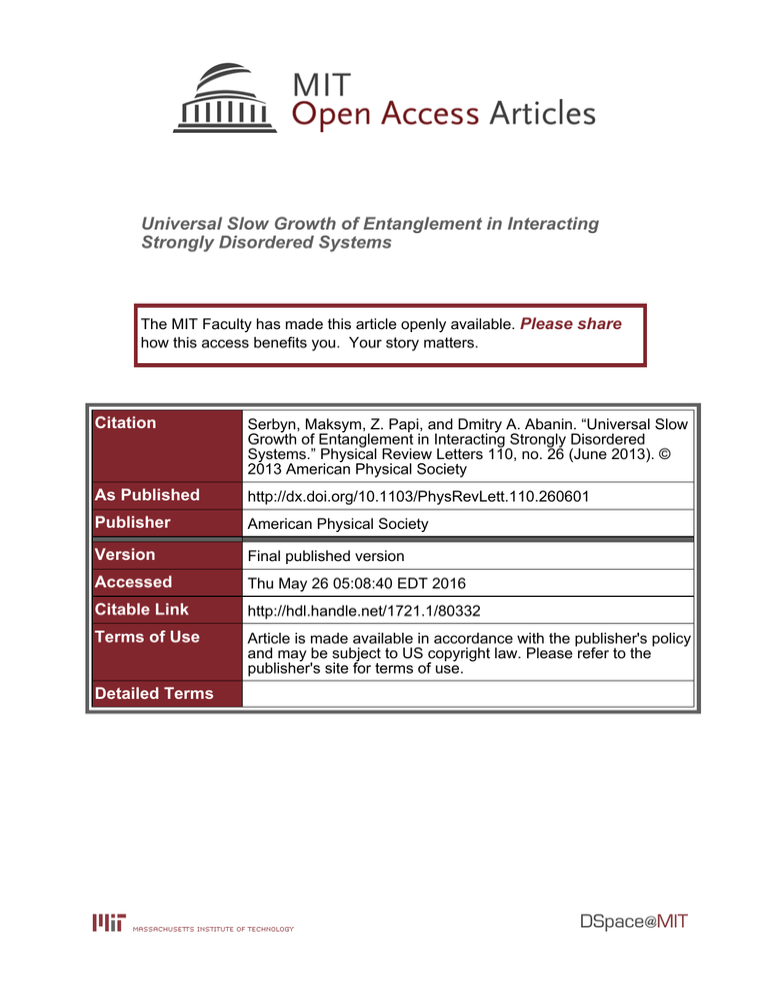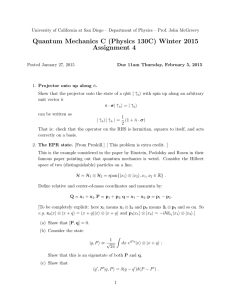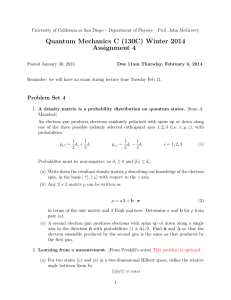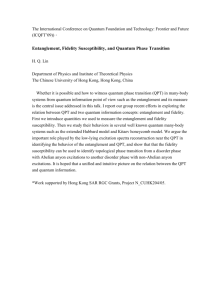Universal Slow Growth of Entanglement in Interacting Strongly Disordered Systems Please share
advertisement

Universal Slow Growth of Entanglement in Interacting Strongly Disordered Systems The MIT Faculty has made this article openly available. Please share how this access benefits you. Your story matters. Citation Serbyn, Maksym, Z. Papi, and Dmitry A. Abanin. “Universal Slow Growth of Entanglement in Interacting Strongly Disordered Systems.” Physical Review Letters 110, no. 26 (June 2013). © 2013 American Physical Society As Published http://dx.doi.org/10.1103/PhysRevLett.110.260601 Publisher American Physical Society Version Final published version Accessed Thu May 26 05:08:40 EDT 2016 Citable Link http://hdl.handle.net/1721.1/80332 Terms of Use Article is made available in accordance with the publisher's policy and may be subject to US copyright law. Please refer to the publisher's site for terms of use. Detailed Terms week ending 28 JUNE 2013 PHYSICAL REVIEW LETTERS PRL 110, 260601 (2013) Universal Slow Growth of Entanglement in Interacting Strongly Disordered Systems Maksym Serbyn,1 Z. Papić,2 and Dmitry A. Abanin3,4 1 Department of Physics, Massachusetts Institute of Technology, Cambridge, Massachusetts 02138, USA 2 Department of Electrical Engineering, Princeton University, Princeton, New Jersey 08544, USA 3 Perimeter Institute for Theoretical Physics, Waterloo, Ontario N2L 2Y5, Canada 4 Institute for Quantum Computing, Waterloo, Ontario N2L 3G1, Canada (Received 24 April 2013; revised manuscript received 7 June 2013; published 28 June 2013) Recent numerical work by Bardarson, Pollmann, and Moore revealed a slow, logarithmic in time, growth of the entanglement entropy for initial product states in a putative many-body localized phase. We show that this surprising phenomenon results from the dephasing due to exponentially small interactioninduced corrections to the eigenenergies of different states. For weak interactions, we find that the entanglement entropy grows as lnðVt=@Þ, where V is the interaction strength, and is the single-particle localization length. The saturated value of the entanglement entropy at long times is determined by the participation ratios of the initial state over the eigenstates of the subsystem. Our work shows that the logarithmic entanglement growth is a universal phenomenon characteristic of the many-body localized phase in any number of spatial dimensions, and reveals a broad hierarchy of dephasing time scales present in such a phase. DOI: 10.1103/PhysRevLett.110.260601 PACS numbers: 05.60.Gg, 05.30.Rt, 37.10.Jk, 72.15.Rn Introduction.—While it is well known that arbitrarily weak disorder localizes all single-particle quantummechanical states in one and two dimensions, the effect of a disorder potential on the states of interacting systems largely remains an open problem. References [1,2] conjectured that localization in a many-body system survives in the presence of weak interactions. When the strength of the interactions is increased, at some critical value a transition to the delocalized phase—a ‘‘many-body localization’’ transition—takes place, as observed in the numerical simulations [3–13]. An important challenge is to understand the physical properties of the many-body localized (MBL) phase. Recent work [14] (see also Ref. [4]) revealed that even very weak interactions dramatically change the growth of entanglement of nonequilibrium many-body states. The authors of Ref. [14] studied the time evolution of product states in a 1D disordered XXZ spin chain. In the absence of interactions, such states maintain a low degree of entanglement upon evolution, and the entanglement entropy Sent obeys an area law. In contrast, in the presence of interactions the states showed a slow, logarithmic in time, growth of Sent (here and below we use ‘‘entanglement’’ and ‘‘entanglement entropy’’ interchangeably). The saturated value of Sent was found to vary approximately linearly with system size, and remained well below the maximum possible value [14–16]. In this Letter, we identify a mechanism that underlies the logarithmic growth of entanglement in interacting MBL states. The key observation is that although very weak interactions have a small effect on the MBL eigenstates, they nevertheless induce small corrections to their energies, which ultimately lead to the dephasing between 0031-9007=13=110(26)=260601(5) different eigenstates at long time scales. We argue that this gives rise to a logarithmic growth of Sent with time for a broad class of initial states that are a product of states in the two subsystems, a special example of which was considered in Ref. [14]. For weak interactions, our mechanism leads to the following predictions regarding entanglement growth as a function of the system’s parameters: (i) entropy grows as Sent ðtÞ / logðVt=@Þ, where V is the interaction strength and is the single-particle localization length; (ii) the saturation value of Sent is of the order of the ‘‘diagonal entropy’’ Sdiag [17] of the given initial state. Diagonal entropy is determined by the participation ratios of the initial state in the basis of eigenstates of the system for V ¼ 0. We also illustrate these predictions with numerical simulations of finite systems, in particular by constructing examples of initial states for which the saturated Sent is equal to Sdiag . Model.—Without loss of generality, we consider a 1D lattice model of fermions with on-site disorder and nearestneighbor interactions X X X H ¼ J cyi cj þ Wi n^ i þ V n^ i n^ j ; n^ i ¼ cyi ci ; (1) hiji i hiji where i; j ¼ 1; . . . ; N, and hiji denotes nearest neighbors. This model is equivalent to the random-field XXZ spin chain [14]. From our discussion below, it will become apparent that the logarithmic growth of entanglement in MBL systems is a robust phenomenon which does not depend on the dimensionality or the microscopic details of the system. We will focus mostly on the regime of weak interactions for which the logarithmic growth of Sent found in Ref. [14] 260601-1 Ó 2013 American Physical Society PRL 110, 260601 (2013) week ending 28 JUNE 2013 PHYSICAL REVIEW LETTERS is perhaps the most striking. In the absence of interactions, V ¼ 0, disorder localizes the single-particle states, with localization length , and the many-body eigenstates are simply states in which a certain number of single-particle orbitals is occupied. Interactions that are much weaker compared to the typical level spacing 1= do not significantly modify the many-body eigenstates. We have explicitly verified this statement for small systems, and assume it holds in general. However, even though the eigenstates are not strongly affected by the interactions, their energies are modified. If we fix the positions of all particles, except for a pair of particles situated at a distance x away from each other, the interaction energy of this pair is Vex= , and the corresponding dephasing time is tdeph @ex= =V. This gives rise to a hierarchy of dephasing time scales present in the problem, ranging from the fastest tmin ¼ @=V to the slowest tmax ¼ tmin eL= , where L is the system size. Generally, the product initial states considered in Ref. [14], as well as the initial states of other kinds considered below, are a superposition of many eigenstates. The interactions introduce a slow dephasing between different states, and effectively generate entanglement between different remote parts of the system. A subsystem of size x becomes nearly maximally entangled with the rest of the system after an exponentially long time tdeph ðxÞ @ex= =V; thus, the bipartite Sent will increase logarithmically in time. Two particles.—Let us start with a simple example which demonstrates that the slow growth of entanglement occurs for just two particles. Consider two distant particles prepared in an equal-weight superposition of two neighboring localized orbitals j0 i ¼ 1=2ðcy1 þ cy2 Þðcy3 þ cy4 Þj0i, where cyi creates an eigenstate localized near site i. We assume that the distance between the support of the wave functions 1, 2 and 3, 4 is large (x ) (see Fig. 1). In the absence of interactions, no entanglement is generated during time evolution. Interactions, however, introduce a correction to the energy of the state ji ¼ cy cy j0i, where ¼ 1, 2, ¼ 3, 4. In the leading order of perturbation theory, the energy of this state is given by E ¼ " þ " þ E , where " , " are the singleparticle energies, and the last term E ¼ C Vex= is due to the interactions, C being a constant which depends only algebraically on x. The time-evolved state is given by jðtÞi ¼ P 1=2 ; expðiE tÞji, and the reduced density matrix for the first particle reads 1 1 FðtÞ=2 ^ L ¼ ; (2) 1 2 F ðtÞ=2 where FðtÞ ¼ eit ð1 þ eit Þ, ¼ E14 E24 E13 þ E23 , and ¼ "1 "2 þ E13 E23 . The eigenstates of ^ L therefore oscillate with a very long period (a) (b) FIG. 1 (color online). (a) Generation of entanglement between two remote particles, each prepared in an equal superposition of two eigenstates. Exponentially small overlap of the orbitals leads to the dephasing time growing exponentially with distance. (b) Sent as a function of time for a given realization of disorder and different interaction strengths. When V ¼ 0, Sent 104 and remains small at all times. For V 0, values of Sent ðtÞ collapse on a single curve when time is scaled by 1=V. System size is L ¼ 10 sites, and disorder strength is W ¼ 6. T ¼ 2= ð@=VÞex= . At times t ¼ ð2n þ 1Þ=, the off-diagonal elements vanish, and the eigenvalues become equal to 1=2. At these times, the particles become maximally entangled with Sent ¼ ln2. Figure 1 demonstrates that even weak interactions lead to the entanglement of the order of Sent ln2, and the rate of entanglement change is inversely proportional to the interaction strength. In Fig. 1, particles are in a superposition of states which are not the exact eigenstates; hence, the maximum value of Sent is slightly below ln2 0:69. Note that no disorder or time averaging is used. General case.—Turning to the general many-body case, let us divide the system into two parts L and R, labeling the single-particle orbitals that are localized dominantly in L by index n , and those residing in R by n . There may be some ambiguity for the state residing near the boundary between L and R, but we will be interested in systems of size L , for which the boundary effects are not very important. We consider initial states that are products of some superposition of states with definite numbers of particles in L and R: X jðt ¼ 0Þi ¼ Afg j1 . . . K i fg2L X Bfg j1 . . . M i: (3) fg2R Coefficients A, B are chosen such that is normalized. Neglecting the change to the eigenstate due to interactions, the reduced density matrix for L after time P evolution reads ^ L ¼ ;0 0 jih0 j, where 0 ¼ P A A0 jB j2 eiðE0 E Þt , and we have used a shorthand notation fg, fg. It is convenient to define 260601-2 PRL 110, 260601 (2013) week ending 28 JUNE 2013 PHYSICAL REVIEW LETTERS A ðtÞ ¼ A eiE t , where E is the energy of the ji state for the isolated L subsystem. Assuming that ji ji remains an eigenstate (this may not be true near the boundary, but the boundary effect is not important for entanglement growth, at least in large systems), the above equation, written in terms of coefficients A ðtÞ, preserves the same form, except the energies E should be substituted by the interaction energy E between particles in the L and R subsystems. For particles that reside far away from the boundary, this correction can be calculated in perturbation theory. The energy difference E0 E that enters the offdiagonal elements of ^ L , to the leading order, is proportional to Vex= . Here x is the minimum distance between a particle in L, the position of which is different in states and 0 , and the particles in R. However, it also contains many smaller contributions, which arise due to the interaction between more distant pairs of particles. Thus, the off-diagonal elements oscillate at a number of very different, incommensurate frequencies. The interaction energy leads to dephasing, which decreases the off-diagonal elements of ^ L , thus generating entanglement. Effectively, at times tðxÞ tmin ex= the degrees of freedom within a distance xðtÞ lnðt=tmin Þ from the boundary between L and R are affected by dephasing, while states that differ only in the positions of particles further away from the boundary are still phase coherent. This generates the entropy X Sent ðtÞ ¼ CSdiag ; Sdiag ¼ Pi ðxÞ lnPi ðxÞ; (4) where Pi ðxÞ are the probabilities of different states ji in a segment of size x, calculated from the wave function of the initial state. Quantity Sdiag is the diagonal entropy—a maximum achievable entropy for a given initial state, assuming that interactions do not change the eigenstates. Sent is expected to be smaller than Sdiag by a factor C & 1; the precise value of this prefactor is nonuniversal, and depends on the preparation of the initial state. In the long-time limit, assuming that R L and the initial state is a superposition of many different states, we expect the off-diagonal elements to become very small such that the entanglement entropy approaches its maximum value with C ! 1. Since for initial product states Sdiag is proportional to the subsystem size, entanglement grows logarithmically: Sent ðtÞ / logðVt=@Þ: of the model (1) with a finite number of particles in a random potential uniformly distributed in the interval [ W, W]. Hopping is set to J ¼ 1=2 and we consider chains with an even number of sites and open boundary conditions at half filling. The number of different disorder realizations ranged from 30 000 (L ¼ 8) to 800 (L ¼ 14); the number of initial states was 2L=2 for each disorder realization. In the figures below, error bars (if not shown) are approximately equal to the size of the symbols in each plot. Using exact diagonalization for systems up to 14 sites, we compute the time evolution of various initial states, which allows us to obtain Sent ðtÞ for half partition. We study its average Sent ðtÞ over different initial states belonging to the same class, and over different realizations of disorder. Similar to Ref. [14], we first consider a class of localized product states (LPS) where each fermion is initially located at a given site. Results for Sent ðtÞ for a system of L ¼ 12 sites and disorder W ¼ 5 are shown in Fig. 2(a). After a rapid increase of entropy on time scales of the inverse hopping, due to diffusive transport on a scale smaller than the localization length, Sent ðtÞ saturates for a noninteracting system. In the presence of even weak interactions, Sent ðtÞ continues to grow further. In full agreement with our analysis above, values of Sent Sent S0 collapse onto a single curve as a function of lnðVt=@Þ [see the inset of Fig. 2(a)], where S0 is the saturation entropy of a noninteracting system. The saturation value Sent ð1Þ does not vary appreciably with interaction strength when interactions are weak. This further supports the conclusion that weak interactions only weakly alter the eigenstates of the system. For fixed V ¼ 0:01, Sent ð1Þ and Sdiag decrease with disorder [see Fig. 2(b)] approximately as 1=W (scaling not shown). Such (a) 0.5 0.4 0.3 1 L=8 L =10 L =12 0.8 0.6 0.4 0.2 3 (c) 0.2 0.2 0 0 10 0 4 5 6 7 8 L=8 L =10 L =12 1 0.8 0.1 0.1 (5) We emphasize that our argument does not rely on averaging, and therefore entanglement grows according to Eq. (5) even for a single disorder realization, and even for relatively small systems. Numerical simulations.—In order to illustrate the above mechanism, and to explore the growth of entanglement for different initial states, we performed numerical simulations (b) V=0 0.0005 0.001 0.005 0.01 0.05 0.1 0 10 20 10 10 0.6 3 4 5 6 7 8 FIG. 2 (color online). (a) Averaged entanglement entropy of initial product states, in which all fermions are localized at some sites, shows a characteristic logarithmic growth on long time scales (system size is L ¼ 12, W ¼ 5). Growth rate is found to be proportional to lnðVt=@Þ (inset). Saturated entanglement (b) and the ratio C ¼ Sent ð1Þ=Sdiag (c) decrease with W (for fixed V ¼ 0:01). 260601-3 PRL 110, 260601 (2013) week ending 28 JUNE 2013 PHYSICAL REVIEW LETTERS scaling stems from the fact that when is of the order of one lattice spacing, the leading contribution to the entanglement comes from rare resonant pairs of neighboring sites (rather than typical off-resonant sites), which occur with probability J=W. Each pair contributes a number of the order ln2 to the entanglement as well as diagonal entropy. We compare the saturated entanglement to Sdiag , calculated using the values of Pi ðL=2Þ for the initial state of the L subsystem. The Pi ðL=2Þ are obtained from the density matrix, using the eigenstates of the interacting Hamiltonian restricted to L. In this sense, while Sent ð1Þ is determined from the time evolution of the system, Sdiag is solely the property of the initial state. To interpret the dependence of the ratio C ¼ Sent ð1Þ=Sdiag on system size and disorder [see Fig. 2(c)], we must take into account two additional effects important for small systems: (i) the diffusion of particles across the entanglement cut; and (ii) the inefficiency of decoherence when the number of terms in Eq. (3) is small or when L and R are of equal size. These effects counteract each other, as diffusion leads to an additional contribution to Sent not captured by Eq. (4). On the other hand, inefficient decoherence leads to incomplete dephasing, and decreases Sent ð1Þ compared to Sdiag . The positive contribution from (i) is suppressed for larger systems or smaller localization lengths. The effect of (ii) depends on the initial state. For LPS in the localized phase, the participation ratio is of order unity, and the effect (ii) is very pronounced. Thus, C is smaller than 1, and it decreases with increasing disorder or system size [see Fig. 2(c)]. Next, we consider a different kind of initial states with larger participation ratios. The initial state of the R and L subsystem is chosen as a projection to the half-filled sector Q pffiffiffi of the state i 1= 2ð1 cyi Þj0i, with signs chosen at random. Particles within each subsystem are therefore strongly entangled, but there is no entanglement between the subsystems at t ¼ 0. In this case, we find the same logarithmic entanglement growth, but Sent ð1Þ [see the solid lines in Fig. 3(a)] is larger compared to the previous case, and varies weakly with disorder. The ratio C [see the upper panel of Fig. 3(b)] now scales to 1 when system size is increased, contrary to the LPS. For this type of initial state, due to larger values of Sent ð1Þ, the boundary diffusion contribution is less important; also, the superposition of a large number of eigenstates in each half of the system makes decoherence more efficient; thus, C is closer to 1. Finally, we construct an example where Sent reaches Sdiag . We take a product of the LPS in L, and the strongly entangled state in R. To further suppress the diffusion, we require the two sites adjacent to the entanglement cut to be always empty. Sent ð1Þ displays the behavior similar to the LPS case [see the dashed lines in Fig. 3(a)], but is larger due to the more effective dephasing. Remarkably, Fig. 3(b) (a) (b) 1.2 3 2.5 L=8 L = 10 L = 12 L = 14 1 2 0.8 3 4 5 6 7 1.5 L =8 L = 10 1.2 1 1 0.5 0 L = 12 L = 14 3 4 5 6 7 0.8 3 4 5 6 7 FIG. 3 (color online). (a) Saturated entanglement entropy as a function of disorder W for a strongly entangled state (solid lines), and a product of a strongly entangled state and an LPS state (dashed lines). (b) Ratio of saturated and diagonal entropy as a function of disorder W for the same two states. For the product of a strongly entangled state and an LPS state (lower panel), C tends to 1 for larger system sizes as W is increased (interaction is set to V ¼ 0:01). demonstrates that for larger system sizes, saturation and diagonal entropies become equal, in agreement with the above analysis. Discussion.—To summarize, we presented a mechanism of the logarithmic growth of entanglement in the MBL phase. We also established the laws governing the entanglement growth, and tested them in numerical simulations for different initial states. We note that in the delocalized phase the entanglement is expected to grow much faster (as a power-law function of time), suggesting that the scaling of Sent can be used as a potential tool for studying the localization-delocalization critical point and its properties. Although we focused on the limit of weak interactions, in which the eigenstates are similar to those of a noninteracting model, we expect our conclusions to hold also for stronger interactions which do modify the eigenstates. In this case, Sent ð1Þ is expected to be determined by the participation ratios of the initial state in the basis of the interacting subsystem’s eigenstates. Furthermore, our conclusions are expected to apply to localized interacting systems in any number of spatial dimensions. Our work indicates an exponentially broad distribution of dephasing time scales present in a MBL system. It gives support to the ‘‘strong-localization’’ scenario of the manybody localization transition, and shows that the entanglement growth arises due to interaction-induced dephasing, rather than due to the effect of interactions on the eigenstates, as was hypothesized in Ref. [14]. We note that recently Vosk and Altman [18] considered an XXZ model with random exchange interactions, but without a random field. For a special initial state, they developed a strong-disorder renormalization group procedure, and found that Sent grows as a power of lnt. The difference from our result stems from the fact that the state 260601-4 PRL 110, 260601 (2013) PHYSICAL REVIEW LETTERS considered in Ref. [18] was critical; however, the basic underlying mechanism—dephasing due to exponentially weak interactions between remote spins—is qualitatively similar. After this Letter was submitted, we became aware of a related independent work [19] where the logarithmic growth of entanglement was established from phenomenological considerations. We would like to thank E. Altman and J. Moore for useful comments on the manuscript. This research was supported in part by Perimeter Institute for Theoretical Physics. Research at Perimeter Institute is supported by the Government of Canada through Industry Canada and by the Province of Ontario through the Ministry of Economic Development & Innovation. Z. P. was supported by DOE Grant No. DE-SC0002140. The simulations presented in this article were performed on computational resources supported by the High Performance Computing Center (PICSciE) at Princeton University. [1] D. Basko, I. Aleiner, and B. Altshuler, Ann. Phys. (Amsterdam) 321, 1126 (2006). [2] I. V. Gornyi, A. D. Mirlin, and D. G. Polyakov, Phys. Rev. Lett. 95, 206603 (2005). [3] V. Oganesyan and D. A. Huse, Phys. Rev. B 75, 155111 (2007). week ending 28 JUNE 2013 [4] M. Znidaric, T. Prosen, and P. Prelovšek, Phys. Rev. B 77, 064426 (2008). [5] C. Monthus and T. Garel, Phys. Rev. B 81, 134202 (2010). [6] T. C. Berkelbach and D. R. Reichman, Phys. Rev. B 81, 224429 (2010). [7] A. Pal and D. A. Huse, Phys. Rev. B 82, 174411 (2010). [8] C. Gogolin, M. P. Müller, and J. Eisert, Phys. Rev. Lett. 106, 040401 (2011). [9] E. Canovi, D. Rossini, R. Fazio, G. E. Santoro, and A. Silva, Phys. Rev. B 83, 094431 (2011). [10] M. Rigol, V. Dunjko, V. Yurovsky, and M. Olshanii, Phys. Rev. Lett. 98, 050405 (2007). [11] F. Buccheri, A. De Luca, and A. Scardicchio, Phys. Rev. B 84, 094203 (2011). [12] E. Cuevas, M. Feigel’man, L. Ioffe, and M. Mezard, Nat. Commun. 3, 1128 (2012). [13] A. De Luca and A. Scardicchio, Europhys. Lett. 101, 37003 (2013). [14] J. H. Bardarson, F. Pollmann, and J. E. Moore, Phys. Rev. Lett. 109, 017202 (2012). [15] G. D. Chiara, S. Montangero, P. Calabrese, and R. Fazio, J. Stat. Mech. 2006, P03001 (2006). [16] F. Iglói, Z. Szatmári, and Y.-C. Lin, Phys. Rev. B 85, 094417 (2012). [17] A. Polkovnikov, Ann. Phys. (Amsterdam) 326, 486 (2011). [18] R. Vosk and E. Altman, Phys. Rev. Lett. 110, 067204 (2013). [19] D. A. Huse and V. Oganesyan, arXiv:1305.4915. 260601-5







